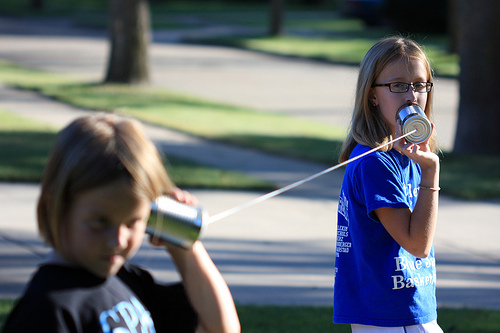Dialog Writing 101: Conversational Mechanics
This month our editors are taking a hard and tough look at Fatal Flaw # 8: Flawed Dialog Construction. Dialog is a tricky component to master in fiction, and it’s easy to fall into numerous traps that will make dialog sound forced or phony, or come across jarring due to bad structure. So we’ll dispel all the mysteries surrounding crafting great dialog, starting with editor Rachel Starr Thomson’s post on Dialog Mechanics.
Dialog is special to me as a writer. Maybe it’s because we live in society saturated with sound—from music to movies, radio, and podcasts. Maybe it’s because I keep up a running conversation in my head at nearly all times of the day, discussing whatever I’m thinking about with invisible conversation partners (before you worry about me, I’m not any crazier than your average creative—I’m just usually hashing things out with God, some author I’ve just been reading, or a friend I hope to talk to soon).
For whatever reason, when a story begins to come to me, I hear it first. To be more specific, I hear dialog first. Before I picture settings, craft worlds, or brainstorm plots, I hear conversations.
The Technique of Conversation
Of all the discrete parts that make up fiction, dialog might be the most dependent on good technique to make it really work. You can put fabulous dialog in your characters’ mouths, brilliant with personality, culture, and subtext—all topics my fellow editors will be discussing over the next three weeks—but if your technique is bad, the words will fall flat.
Thankfully, good dialog technique is not hard to learn or to master. Much of it comes down to simple rules and tricks.
My Before and After passages this week represent two versions of a scene from my novel Renegade.
BEFORE:
Tyler was sitting out front, whittling a branch with a rusted knife he’d found in the desk inside the cabin.
“Reese, hey. Out for a hike?” he said welcomingly.
“Yeah, Tyler,” she said.
“Can’t be easy with your ankle,” he nodded.
“It isn’t easy, Tyler. But the ankle’s healing. It’s a workout, getting through the woods on crutches. I’m pretty tired after doing this for weeks, but I hope it will get better soon,” she said.
“Y’know, Reese, if you want company, all you have to do is ask,” Tyler said.
“Where’s Jacob, Tyler?” she asked.
“Off somewhere like usual, Reese,” Tyler shrugged.
Overhead, the sky was darkening. Reese looked up and frowned.
“Tyler, get inside,” she said worriedly.
“What, Reese? What’s going on?” he asked questioningly.
“Just get inside,” she said commandingly.
“What’s going on, Reese?” he asked persistently.
“Would you get inside, Tyler?” she shot back hotly.
“No, Reese. I’m going to help you,” he insisted.
“Fine, Tyler. But whatever happens, it’s not my fault,” she said with annoyance.
Inwardly, she laughed with derision at her own words.
Was anything not her fault?
The actual dialog in the passage above isn’t bad. Most of it will be retained in the passage below. But it has a few key (and common) problems:
- The characters constantly address each by name. (In real life, we almost never do this.)
- It uses a speech tag after every line of dialog, which is wholly unnecessary and oftentimes annoying.
- The speech tags always come at the end of the dialog, even when that’s awkward.
- It uses adverbs to tell what the dialog itself is perfectly capable of showing. (Yes, I had to stop myself from writing “he insisted insistently.”)
- The passage doesn’t use action or setting details, so all we have is talking heads in white space. This detaches readers from the scene. It’s also lacking in any inner speech from the POV character, so there’s an entire underlayer missing.
Here’s the difference when the above problems are corrected:
AFTER:
Tyler was sitting out front, whittling a branch with a rusted knife he’d found in the desk inside the cabin.
“Hey,” he said, looking up as Reese approached. “Out for a hike?”
“Yeah.”
“Can’t be easy with your ankle.”
Reese laid her crutches aside and lowered herself beside him, using the cabin wall to steady herself. “It isn’t. But the ankle’s healing.”
Tyler nodded. “Good.” Then he frowned. “You okay? You look like you just ran a marathon.”
“It’s a workout, getting through the woods on crutches.”
“Okay.” He seemed less than convinced. “Y’know, if you want company, all you have to do is ask.”
She didn’t say the answer that ran through her head. No good. It’s not safe to be with me right now. They’re after me, and I’m not sure why. Better you don’t get yourself killed being company.
Tyler was a good kid with a good heart, but he had no battle training. She was happiest having him far away while she fought off the attacks.
“Where’s Jacob?” she asked.
“Off somewhere. Like usual.”
Overhead, the sky was darkening. Reese looked up and frowned. Clouds were blocking out the open spaces between the pines—clouds and something else.
“Tyler,” she said, “get inside.”
“What? What’s going on?”
“Just get inside.” She reached for the wall and got to her feet. Tyler jumped up but didn’t make a move to go in. She went to glare at him and saw a sword in his hand. He held it up.
“What’s going on?” he asked.
“Would you get inside?”
“No. I’m going to help you.”
“Fine,” she said through gritted teeth. “But whatever happens, it’s not my fault.”
Inwardly, she laughed with derision at her own words.
Was anything not her fault?
Breaking Down the Difference
As I said, much of good dialog technique comes down to simple rules and tricks. I tackled five of them above. 1. Don’t use direct address.
For some reason, it’s really tempting to have characters address each other by name in dialog. The more heated and intense the scene, the more writers will tend to do this. It’s like we think the dialog sounds more serious if we keep repeating names: “Listen, Rachel, don’t ever write dialog like this, Rachel, do you get it, Rachel?”
In the Before passage, Reese and Tyler address each other by name a total of twelve times. They do this despite the fact that there is no one else in the scene and they could not possibly be talking to anyone else.
The rule for direct address is pretty simple: don’t do it. You’ll want to break that rule once in a while, of course; the trick for knowing when it will work is equally simple. Ask yourself whether you would address someone by name in this situation in real life. If you would, it will probably work in dialog. If you wouldn’t, cut it.
Use Speech Tags Sparingly; Alternate with Action Beats
Beginning writers often feel that they need to identify every speaker, every time, with a speech tag (“he said,” “she replied,” etc.). You don’t. Structure will identify the speaker in most cases, especially when there are only two people in a conversation—just start a new paragraph when a new person speaks or acts.
Conversely, though, when you have three or more characters in a scene, you need to be sure it’s clear who is speaking—every line.
You can also use action beats to identify the speaker. That’s what I did in the following:
Reese laid her crutches aside and lowered herself beside him, using the cabin wall to steady herself. “It isn’t. But the ankle’s healing.”
Using action beats (or narrative tags) this way has two more advantages: it defeats the “talking heads in white space” problem, and it can subtly advance the plot.
One more thing about speech tags: make sure that when you do use them, you primarily stick with “said.” “Said” is invisible; most other tags aren’t. And beware of speech tags that are not speech tags. Did you notice that in the Before passage, Tyler “nodded” and “shrugged” some of his dialog? Nodding and shrugging are not forms of speech, so they can’t be used as dialog tags. This is a surprisingly common gaffe; watch for it when you edit.
Move Your Speech Tags Around
The end of a line of dialog can be the best place for a speech tag, but often it’s better near the beginning, especially when the character has a lot to say. They should never come at the end of a long passage of dialog. Remember this one from the Before passage?
“It isn’t easy, Tyler. But the ankle’s healing. It’s a workout, getting through the woods on crutches. I’m pretty tired after doing this for weeks, but I hope it will get better soon,” she said.
That “she said” is like a flat note at the end of a bar of music. Ugh. Don’t do that. Also, with long paragraphs of speech, putting the speech tag at the end forces the reader to stop reading and skim to the end to figure out who’s speaking, and that disrupts the flow and enjoyment of the read.
In the second passage, this whole paragraph is actually broken up into a more conversational flow, but it could be improved just by moving the speech tag:
“It isn’t easy,” she said. “But the ankle’s healing . . .”
Don’t Use Adverbs
I’m not an anti-adverb lobbyist, but I hope the Before passage demonstrates just how ridiculous they can be. Where dialog technique is concerned, let the words convey their own tone. Don’t use an adverb to TELL what the words clearly SHOW. If the words don’t clearly show what they need to, consider rewriting them.
Use Other Elements
Anytime dialog takes off completely on its own, it creates a lot of white space full of sound—and only sound. We can’t see; we can’t feel; we don’t know what the characters are thinking. We lose touch with the story world.
Intersperse dialog with bits of action, description, and internal speech. Your readers will thank you for it—and more importantly, they’ll stay immersed in the story.
Your turn:
How do you feel about writing dialog? Do you love it, hate it? Did you observe anything else in the Before and After passages that’s worth pointing out? Do you have more to add to the techniques listed here?











Great post with some key guidelines. Thanks. But one structural thing I’m still wondering about… You say: “—just start a new paragraph when a new person speaks or acts.”
How about new paragraphs from the SAME person? I notice you do it above (POV action beat > “Tyler,” she said, “get inside.”) I sometimes find myself trying to cram all of one character’s “stuff” into the same graph, then moving to the next person’s graph. But then paragraphs get long and complex. Any guidelines on when to start new paragraphs (with or without dialogue) for the same person? Thanks!
Thanks, Harald. You can have multiple paragraphs of speech, and it’s good to break up long passages like that. When you do that, you leave off the final quote mark at the end of a paragraph and the next new paragraph starts with a quote. However, be careful not to have long monologues unless it’s in character and fits the scene. That’s basically it.
Thanks!
Thanks for your comment, Harald! Susanne’s advice is good, of course. I tend to start a new paragraph for dialog at all times, as in the example you cited, because I prefer the rhythm it creates and it’s still clear. But note I did use a speech tag there so there’s no confusion as to who’s speaking. In other words, this isn’t hard and fast–do what works :).
Thanks, Rachel. Yeah, that was my question. I notice that some writers tack dialogue lines at the tail end of descriptive lines in the same graph. And I’ve been playing with that. Agree: I think the key to the choice is the rhythm flow.
Oops… forgot to nest this under Rachel’s reply above of Aug 6.
What a great article. Dialog used to be my downfall. I’m getting better, and your suggestions help. One thing I do to help me keep up with authentic dialog is to set up avatars (because I no longer have my Barbie dolls) and play – act my way through the scene. If it comes across as xontrived, it is, and I rewrite.
Really love your posts.
Connie
Huh, why don’t you play with Barbie anymore? Might be useful for trying out that “Valley Girl” dialog!
Thanks, Connie! I’m glad my suggestions were helpful. And I love the idea of playacting through a scene! What fun. It reminds me of how I started writing stories in the first place: as a kid in the backyard, playing with toys or toads or whatever was handy.
I love dialogue. Since I write contemporary romance, “witty banter” is a great device for creating tension and conveying character. It also helps create rhythm and pacing. But, like anything else you write, it needs to be pruned, shaped, expanded, and if it’s banter for the sake of banter, the story gets lost. And too much without including other elements like action, description, and interior monologue can make a scene too linear, too quick and “surface-y.”
All in all, like any other part of writing, it comes more naturally the more you practice. The tools mentioned in this post will help a writer do that.
Glad I’m not the only one who has internal conversations constantly running through her head. Unfortunately, that sometimes lead to me actually talking to myself. I get a lot of strange stares. But it can be a good habit to have if you don’t want anyone to bother you when you’re in public, like those annoying people trying to sell you something or sign some political petition.
Ha, I think we ALL have conversations in our heads. Pretty sure it’s prerequisite to being a writer! And you’ve got it: practice is absolutely key. That and reading other people’s (good) writing. I still don’t know any better way to develop an ear for what works.
I have to concede I once suffered from an extreme case of adverbalism. Almost every word I jotted down had an adverb attached to it. Several years ago, when I was a member of a local Toastmasters group, I asked someone to keep track of the adverbs I used throughout a speech. I had just then become conscious of my tendency towards their over-usage and I wanted to count them – literally – and tell me exactly how many I spat out during the 10-minute speech. The number was something like 25. He stopped counting after that. When I hired a professional editor to review my first completed novel last year, she pointed out that my adverbalism had reared its ugly head again. I went back through the novel and eliminated as many as I could; much like pulling weeds from a garden. Only then did I realized how much more smoothly the story flowed. Now, as I work on new stories, I keep my adverb alert set on high.
Thanks for sharing that, Alejandro! Wow, I’ve never even thought about how I use adverbs in speech. Fascinating experiment.
A while back I caught myself using “very” while speaking, and realized I was using it pretty often as filler when describing something as I spoke.
I also realized that if I’d been one of my own clients doing that in a book, I’d have been telling myself to lose “very” and replace my modifiers with ones that can stand on their own two feet. “Very” is the adverb’s adverb.
You may be planning to address this in a future post. If so, I can wait. I’ve worked in a few scenes mixing dialogue with narrative. In those cases, I do not necessarily change paragraphs each time someone different is speaking. Thoughts? Suggestions? Warnings?
So sorry for posting three times. Kept getting an error message, so I thought it wasn’t going through.
For what it’s worth, I follow the custom of changing paragraphs with each speaker change, but sometimes I feel like breaking that rule in special circumstances. I’m not sure how to describe them.
As I recall, it might be when I’m in a segment of backstory when the POV character is remembering a previous conversation and reflecting upon it in a rather stream of consciousness manner?
I’m not sure that helps. I look forward to what Ms. Starr has to say.
Jim
No worries! I had a little trouble with comments myself this morning, or I would have answered this sooner.
It’s hard to give advice without an example of what you mean, but in general, I would advise sticking with the “change paragraphs if it’s a new speaker” rule. There are few things more jarring/confusing than realizing you’ve been misinterpreting who is talking, and paragraphing is a huge visual cue for that–speech tags can actually get skimmed over more easily. This isn’t a rule I mess with often.
Jim’s example could work, though. I’d say if you’re not sure, have someone read it over and tell you if they’re confused or unsure about who’s speaking.
My bad on the comments. For those who comment on the blog for the first time, I have to approve the initial comment. I was up in the mountains out of Internet range, camping and looking for bears. So just now got in to approve the waiting comments. Sometimes the fast-paced world just has to go on hold for a few hours!
Good for you. We all need to go “off the grid” sometimes.
Yes, it is hard to explain what I’m doing. Just didn’t know if giving an example was appropriate here. Got some feedback from one of my readers tonight. She said it was clear. Will wait to hear from others as well.
When we talk we often relate what someone else has said. So how is this punctuated within the story?
If a character is quoting what someone said, you would use single quotes within a double quote. Or you can paraphrase: “Joe told me yesterday how he caught that big fish.”
There are a number of ways you can have a character relate what someone else said, but these are two primary ways.
Thank you! I had a fear of dialogue and it really held me back. Your posts have given me so much encouragement!
Thank you for this wonderful post!
Foremost for me was the knowledge that the internal dialogue, with myself (or selves), with fictional characters (or between fictional characters), with friends/family/God, etc… is not just me! Phew!!!
Over the years I’ve asked many non-writer friends about the voices in their minds, and I can tell from the unusual cock of their heads when they say, “Uh, sure.” that they don’t really do this too, they’re just trying to make me seem less frightening! Haha.
I also hear conversations before anything else with a story. In fact, I have pages of random dialogues that wont quit my mind until “told” – they just don’t (yet) fit into an actual story!
Also loved the information about writing dialogue in the post (!!), I’ve printed this post for reference to tighten up some of my written dialogue – thank you!
Ali J
Just remember, when you mention internal dialogue to someone who doesn’t think they have it, the voice in their head is saying, “What does she mean, voice in my head? I don’t have a voice in my head!” That always gives me a laugh.
Ha-ha! Love that!
Glad this helps you! Yes, we all talk in our heads! That’s a human thing. I imagine some animals do, and while it may sound like gibberish to us, they know what they’re thinking!